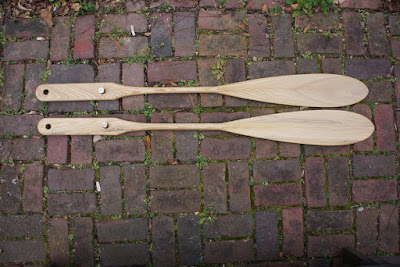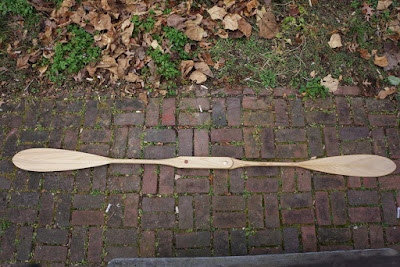I hate to say it but light weight is a big help.. And they tend not to be cheap..In this case I think its better to avoid wood ( my husband would disagree..but I find his paddle enormously heavy).I have had a carbon fiber paddle for over ten years
I don’t mind saying it. Weight matters a great deal with a canoe length double blade, where you are lifting and swinging one sizable end of that stick out of the water on each and every stroke.
We started with 277cm Mohawk double blades. Aluminum shaft and plastic blades.3 lbs 4.2 oz. There were not many choices at the time in canoe length doubles; Mohawk, Shaw & Tenney, DIY or custom made.
Mohawk’s aluminum shafts are cold and not indexed, and the feather is an awful 80 degrees. I can perhaps credit my arm strength and endurance to using those Mohawks for 10 years. We still have them; it’s hard to kill a Mohawk.
And I don’t disagree about wood doubles. We moved on from the Mohawks to Bending Bending Branches laminated wood doubles. 270cm, indexed oval shaft, 60 degree feather, but only slightly lighter at 3 lbs, 2.8 oz. The wood was warmer and every facet of the shaft and blade design far superior to the Mohawks, but they were not much lighter.
And finally, skipping the fiberglass stage, moved to carbon fiber doubles. The carbon 260 Werner Camano weighs 1 lb 12.6 oz in carbon. I have not touched a Mohawk or wood double in years.
A story; I had a friend visiting, let’s call him Willie. We went out for a group day paddle and I lent him a decked canoe and one of the wood doubles. Willie is accustomed to a carbon double at home.
100 yards from the put in and Willie was already 90 yards behind. The b*tching and moaning became so intense someone finally swapped paddles with him. Can’t say as I blame him, once you go carbon. . . . .
But even without going the full on pricey carbon route there are now canoe length doubles available from a bunch of manufacturers, including some well designed mid-range choices in glass shafts and nylon blades. We have a 250cm Aqua-Bound fiberglass MantaRay that weighs just under 2 lbs 8oz. A little over $100 and still light enough that even Willie could swing with it.
Time for some rudimentary math. A Mohawk of BB wood double is 3.25 lbs. The carbon Camano is 1. 75 lbs. That’s a pound and a half difference. Let’s say I’m really only lifting and swinging half that weight difference on each stroke. . . . .12 oz.
12 oz on every stroke. I have no idea of my average strokes per day, pick a random round number. 5000 strokes a day. 12oz X 5000 strokes = 60,000 oz. Someone check my math, but that looks like I was lifting an extra 3750 lbs every day.
Yeah, weight matters. Like going from a Feathercraft to a Zaveral.
Shaw and Tenney does make some but for me they are too heavy.
http://www.shawandtenney.com/engravableproduct/touring-kayak-paddle
We had one, solid wood 280cm, 3 lbs 4.2 oz but it somehow felt much lighter, oddly balanced with remarkably light blade swing weight. Near dripless because of the throat design and very quiet on the pull, with a different water feel from any other double I have used.
The Shaw and Tenney also the
most delicate blade of any paddle I have owned. I cracked and repaired the blades twice in short order before deciding I just couldn’t trust it and gave that paddle to a friend.
He has cracked the blades a few times himself, and despite the weight and fragility it remains his favorite double. YMMV.


